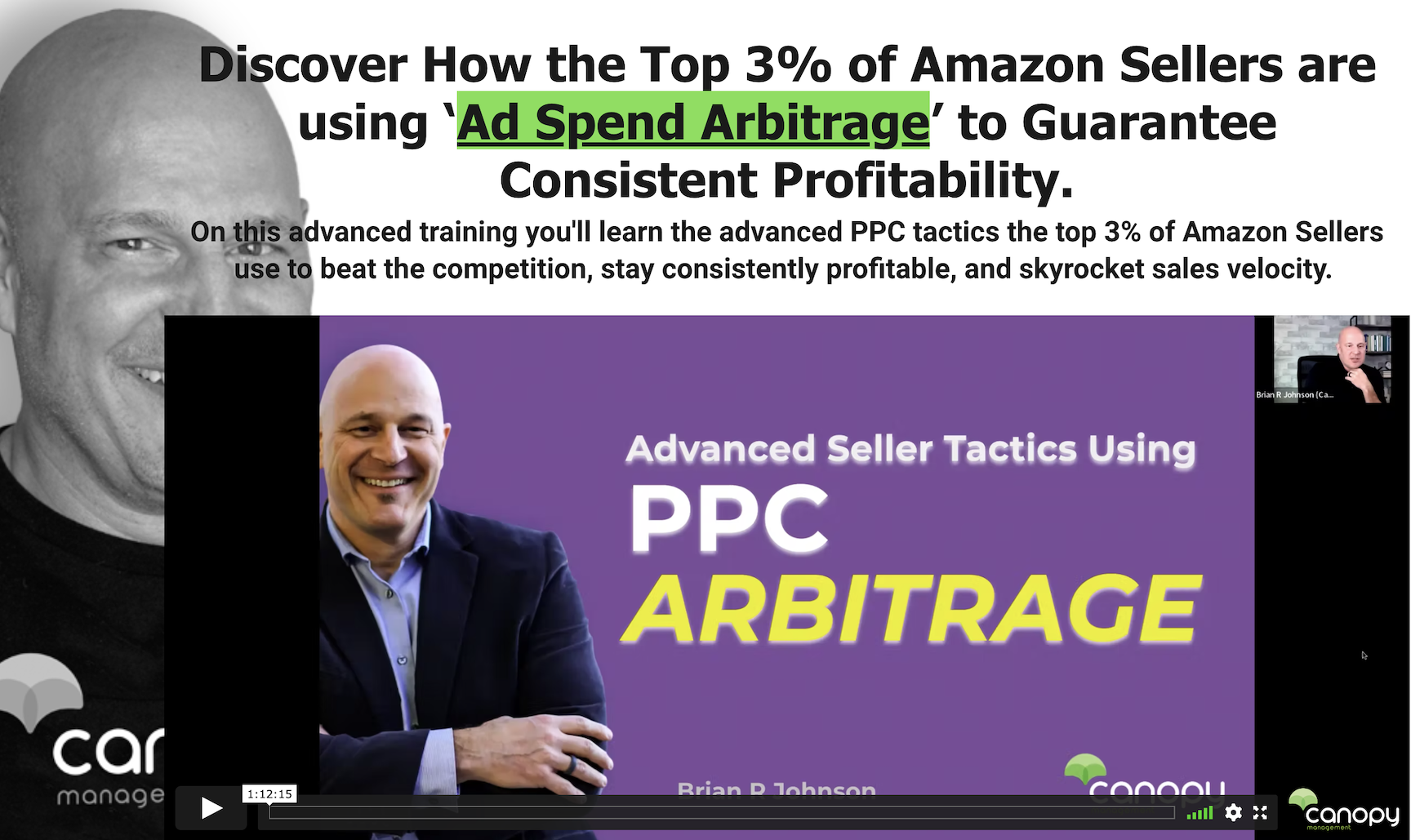Maximizing Profits for Amazon Sellers: Mastering PPC Advertising “Arbitrage”
Updated November 24, 2023 – Your most profitable Amazon products might be hiding in plain sight. This PPC training demonstrates exciting new strategies to increase sales!

A successful Amazon PPC campaign requires a lot of agility and fast footwork. To be profitable, Amazon sellers need to be able to adjust their bidding strategies to maximize visibility and minimize spend.
One main way of doing that is determining how to quickly and precisely shift ad spend away from lower performing ads to those PPC campaigns that are driving sales.
An Amazon PPC agency uses a number of proven processes to make sure that their ad spend is putting dollars in the pockets of their clients.
One way that Canopy Management’s advertising wizard, Brian R Johnson likes to think about it is to reduce it to a simple two step process:
- Determine the Amazon listings that seem to be driving sales
- Then, pay close attention to the net profit contribution
Net contribution is an often-overlooked element of an Amazon seller’s game plan. It factors in the profit that’s left after subtracting advertising costs. This advanced Amazon PPC strategy involves redirecting your ad budget to products that show a higher ROI (Return on Investment).
Thinking About Hiring an Amazon Management Agency?
Canopy’s Partners Achieve an Average 84% Profit Increase!
Let’s talkSuccessful Amazon PPC management means digging deep to identify your highest converting products, then making sure they’re getting the traffic they need to really TAKE OFF!
Amazon “Arbitrage” PPC Strategy
There are a number of ways to get started selling on Amazon, but one of the easiest is through the process of arbitrage.
Using retail arbitrage, sellers purchase products from retail outlets (often at a discount) then turn around and sell those same discounted products on Amazon for a profit. Amazon online arbitrage duplicates that process but substitutes online retailers.
There are no suppliers or manufacturers involved. Once you’ve done your Amazon marketplace keyword research, it’s easy to get started and a quick way for many to start selling on Amazon. Sellers can later transition to another model once they’ve built up the “seed” money to do so.
When Amazon arbitrage succeeds, it’s because smart sellers take an undervalued asset from one location and, using optimization and Amazon PPC advertising strategies, bring a lot of attention to the very same product listing!
This post is going to highlight the way that clever Amazon sellers can do the exact thing with their Amazon pay per click advertising.
Your Best Amazon Listings Are Hiding in Plain Sight
An Amazon arbitrage seller doesn’t pay a penny in storage fees. That’s because their “products” are already stacked on store shelves or on an online catalog.
As an e-commerce seller, the Amazon listings that you should be directing your advertising dollars towards might not be those that you’re making the most money from. Instead, like a great arbitrage product, there’s a good chance that your real best seller is hiding in plain sight.
Retail arbitrage involves a lot of legwork. Sellers must source the products from actual shelves in big box and other retail stores. Online arbitrage sellers take advantage of the vast online catalogs of these same businesses to do the same thing.
If you’re an Amazon seller using PPC advertising to get your products the kind of visibility they require, there’s no driving required, you just need to take a closer look at the data.
What Most Amazon Sellers Get Wrong
Like most of us, Amazon sellers are often blinded by success. As soon as entrepreneurs begin to dig into their businesses’ important metrics, they usually don’t get much further than, “what’s my top seller?”
When it comes to Amazon sales, they need to look deeper.
Questions such as, “Are my products properly optimized?” “Should I increase my Amazon sponsored ads spend?” And finally, “what’s my advertising cost or conversion rate?”
The last question is the basis of the next part of this blog post. Because, that’s where Amazon sellers often receive the shock of their e-commerce lives.
I’m talking about the moment when a seller realizes that they’re pouring money into a product that’s just not converting. More importantly, they’re overlooking a product that with the right Amazon PPC strategy, is poised for success.
Let’s take a quick look at the three types of Amazon PPC ads that you’ll most likely be using.
What Are Sponsored Product Ads?
Amazon Sponsored Product ads help sellers get their product listings in front of shoppers searching for similar products.
An advantage of this type of Sponsored ads is that they don’t look like an ad. There’s just a small “Sponsored” tag at the top of the listing.
That makes Amazon Sponsored Products Ads very versatile. They can be used to achieve a range of marketing goals such as driving traffic to product listings, generating sales, launching new products, and clearing excess inventory
What Are Sponsored Brand Ads?
Sponsored Brand Ads help sellers boost brand visibility and showcase their range of products and Amazon Store.
This type of PPC ad is featured prominently at the top of related search results. Over the last few years, Amazon has expanded potential placements to include spots at the sides or bottom of the search results page or on a product detail page.
Amazon sponsored brands ads appear in shopping results and feature a custom headline, your brand logo, and selected product portfolio.
Sponsored Brands Ads can help you retain buyers and increase brand loyalty. Sending customers to your store through this form of Amazon PPC ad creates an opportunity for shoppers to see additional products that may interest them. This is especially great for brands that have a catalog of closely-related products.
What Are Sponsored Display Ads?
Sponsored Display Ads can show up all across the internet-not just on Amazon! They can appear on the Amazon home page, shopping result pages, product detail pages, and third-party websites and apps.
To keep your Amazon listings top-of-mind, product display ads can help brands to reach potential customers across multiple channels. They do it by using auto-generated ad creatives. These creatives prominently feature their product along with elements of Amazon’s own branding (like star-rated and the recognizable “add-to-cart” button).
It’s Time to Realign Your Amazon Ad Spend
To optimize for Amazon SEO, and fine tune the ad campaign, Canopy Management‘s Brian R Johnson likes to really drill down to look at three distinct sets of metrics.
- Impressions that give you a sense of your product’s overall visibility
- Sessions and CTR (Click Through Rate) indicating engagement
- The Conversion Rate that translates directly to sales
Impressions help tell whether or not shoppers saw the ad or listing in the first place. Was the search term relevant? Did the listing jump off of the Amazon page. Most critically, did the main image stand out?
Sellers can use sessions and CTR to determine if customers are genuinely interested in their product and have been ‘seduced’ by their Amazon listing.
Lastly, the sales figures reveal purchase intent, and whether your listing was able to clearly demonstrate the product’s benefits.
Canopy Management’s PPC Advertising Strategies
In this Amazon advertising training, Canopy Management revealed exciting new strategies that experienced Amazon sellers can use to great success.
The training shows that by looking closely at your PPC data in new ways, you can quickly make decisions to keep your hard-earned money in your bank account AND bring higher visibility to the products that really deserve it!
Amazon listing optimization and PPC advertising spend go hand in hand. This training guides you in understanding not just which lever to pull, but also in what order, whether it’s for sponsored product, sponsored brand, or sponsored display.
That’s the part that many very talented sellers forget!
Click here to watch the replay of the training, or simply click the image below.

How Canopy Management Can Help
That maturity of Amazon’s marketplace has made it a little harder for online sellers to be successful. If you listen to e-commerce podcasts, you’ll often hear the phrase, “treat selling on Amazon like a real business.”
Everything from your Amazon listing optimization to your fulfillment process requires an increased level of sophistication to scale past a certain level.
That’s the main reason why there’s been such a big increase in the number of Amazon sellers taking a closer look at Amazon PPC management.
Canopy Management is a full-service marketing agency for Walmart and Amazon sellers. Our team consists of former Amazonians, multi-million dollar sellers, and award-winning experts.
When you consider the many ways that Canopy Management can help you grow your business, you’ll see why selling on Amazon is much easier “under the Canopy”:
- Strategic Growth Planning
- Listing Copywriting Optimization
- Listing Photography
- Product Videography
- Advertising Management
- Customer Service
- Demand Side Platform (Amazon DSP)
- Amazon Posts
- Full Service Management
- Amazon Review Aggregation


